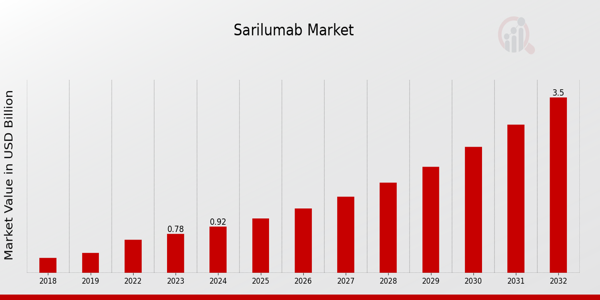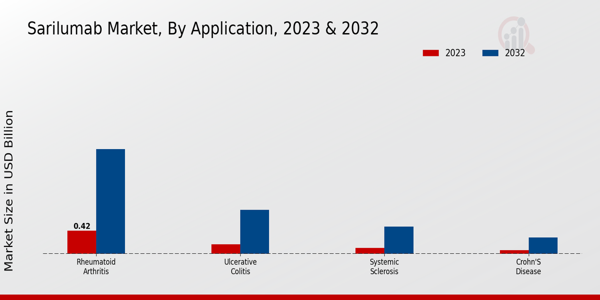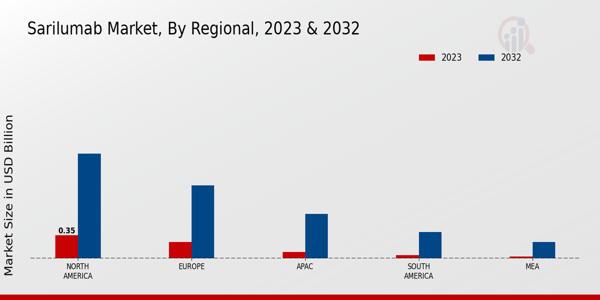Global Sarilumab Market Overview
As per MRFR analysis, the Sarilumab Market Size was estimated at 1.09 (USD Billion) in 2024. The Sarilumab Market Industry is expected to grow from 1.29 (USD Billion) in 2025 to 5.78 (USD Billion) till 2034, at a CAGR (growth rate) is expected to be around 18.16% during the forecast period (2025 - 2034).
Key Sarilumab Market Trends Highlighted
The Sarilumab Market is primarily driven by the increasing prevalence of rheumatoid arthritis and other autoimmune diseases. As more individuals are diagnosed, there is a greater demand for effective treatments, pushing pharmaceutical companies to innovate and expand their product offerings. Additionally, the rising awareness about available therapies and the growing healthcare infrastructure in emerging markets contribute to the market's positive trajectory. Significant opportunities are to be explored in the application of sarilumab in treating other inflammatory diseases beyond rheumatoid arthritis. This could include conditions such as juvenile idiopathic arthritis or other chronic inflammatory disorders where existing treatments may not be sufficiently effective.
The growth of clinical research and studies aimed at exploring the drug’s target market may potentially provide new opportunities in this segment. New elements of the trend lead us to believe that the evolution of personalized medicine is underway and no longer merely mirages on the horizon of the post-load medical paradigm. This strategy may also increase the quality of sarilumab, pushing clinician specialists to adopt it for mixed patient populations. Moreover, partnership between pharmaceutical companies and research centers has gained popularity with similar objectives for drug formulation and delivery enhancement Moving toward implantable or injectable systems, new drug delivery strategies as well as combinatorial approaches with already available treatments become popular raising the chances and results of patient compliance.
With rapid market change, such understanding and strategies to target the gaps in treatment will continues to be admired with regard to extension of stronghold in the market by industry players.

Source: Primary Research, Secondary Research, MRFR Database and Analyst Review
Sarilumab Market Drivers
Increasing Prevalence of Autoimmune Diseases
The rising incidence of autoimmune diseases, particularly rheumatoid arthritis, is a significant driver for the Sarilumab Market Industry. Autoimmune disorders are becoming increasingly common due to various factors, including environmental triggers, genetic predisposition, and lifestyle choices. As the population ages and the prevalence of these diseases escalates, the demand for effective treatment options such as Sarilumab is expected to surge.Sarilumab, as a potent interleukin-6 receptor antagonist, offers a targeted approach that can effectively manage symptoms and slow disease progression. This rising demand for innovative therapies is propelling growth in the Sarilumab Market Industry. Additionally, heightened awareness regarding autoimmune disorders has led to an increase in diagnoses, further fueling market expansion. Patients are actively seeking advanced biologic treatments that offer more substantial benefits than traditional therapies, leading to a clear preference for products like Sarilumab.The continuous evolution of treatment protocols focused on personalized medicine enhances the appeal of Sarilumab. As healthcare professionals increasingly seek to provide patients with tailored treatment options, the Sarilumab Market Industry is poised for considerable growth. Moreover, the greater emphasis on patient education and advocacy has seen more individuals diagnosed earlier in their disease course mandating earlier and more intensive treatment regimens.This trend will drive the demand for Sarilumab and similarly positioned biologic drugs in the coming years. Another critical aspect of this driver is the impact of regulatory approvals that facilitate the entry of Sarilumab into new markets and patient populations. The expanding landscape of clinical guidelines and recommendations further validates the necessity for these therapies in standard healthcare practices. In summary, the increasing prevalence of autoimmune diseases acts as a fundamental pillar for future growth and opportunities within the Sarilumab Market Industry.
Advancements in Biotechnology
Technological advancements in biotechnology have spurred significant innovations in drug development and manufacturing processes. The Sarilumab Market Industry is benefiting from these advancements as emerging biopharmaceutical companies and research institutions develop more efficient and effective biologics. Enhanced biomanufacturing techniques ensure the production of high-quality drugs with greater consistency and reliability. The integration of personalized medicine approaches allows for the development of tailored therapies, ultimately driving the demand for novel biological products like Sarilumab.As the industry continues to evolve, these technological advancements will promote growth and accessibility within the Sarilumab Market Industry.
Rising Healthcare Expenditure
Global healthcare expenditure has been on the rise, and this trend significantly influences the Sarilumab Market Industry. Increased investments in healthcare infrastructure, research, and patient care funding provide a conducive environment for the adoption of advanced therapies. As healthcare systems allocate more resources to combat pressing health issues, innovative treatments like Sarilumab are becoming more accessible to patients. This growing financial commitment to healthcare serves as a catalyst for market expansion, enabling patients and healthcare providers to opt for modern solutions that address severe autoimmune conditions effectively.
Sarilumab Market Segment Insights
Sarilumab Market Application Insights
The Sarilumab Market is fundamentally driven by its diverse applications, primarily including conditions like Rheumatoid Arthritis, Ulcerative Colitis, Systemic Sclerosis, and Crohn's Disease. In 2023, the market for Sarilumab stands at a commendable value of 0.78 USD Billion, with Rheumatoid Arthritis commanding the largest share within this segment, valued at 0.42 USD Billion. This condition reflects a significant demand due to its high prevalence globally, positioning it as a major contributor to the overall market growth. On the other hand, Ulcerative Colitis holds a valuation of 0.18 USD Billion in 2023, highlighting its importance in the therapeutic landscape as an inflammatory bowel disease that affects millions and drives a consistent need for effective treatments. Furthermore, Systemic Sclerosis, with a market valuation of 0.11 USD Billion, suggests a concentrated focus on rare but impactful autoimmune diseases, emphasizing the importance of specialized therapies that cater to niche conditions. Crohn's Disease, though valued at 0.07 USD Billion, still plays a significant role in the fabric of inflammatory bowel diseases, underscoring the ongoing need for innovative treatments that address chronic conditions. As the market evolves, these applications underpin the Sarilumab Market revenue, with Rheumatoid Arthritis maintaining a majority holding due to its widespread prevalence and treatment options. The increasing recognition of effective management strategies for these conditions positions the Sarilumab Market to harness substantial opportunities for growth, especially as awareness and diagnosis continue to rise.Notably, the growth drivers in this market extend beyond just disease prevalence. Advances in biotechnology and significant investments in research and development for immunotherapy are propelling the market forward. However, challenges such as high treatment costs and the complexity of administration may affect uptake rates. Despite these hurdles, the opportunity lies in enhanced patient management programs and improving accessibility to treatments for the above-mentioned conditions. As the landscape of the Sarilumab Market continues to develop, the segmentation around Applications like Rheumatoid Arthritis and Ulcerative Colitis highlights the significant potential and varied needs of patients, thereby shaping the industry's trajectory toward greater innovations and solutions. All elements considered, the Sarilumab Market statistics reflect a trend of growth and diversification across these medical applications, promising a transformative impact on patient care and treatment efficacy moving into the next decade.

Source: Primary Research, Secondary Research, MRFR Database and Analyst Review
Sarilumab Market Route of Administration Insights
The Sarilumab Market encompasses various routes of administration that are pivotal for delivering therapeutic benefits, particularly focusing on Subcutaneous Injection and Intravenous Injection. In 2023, the overall market was valued at 0.78 billion USD, with significant growth projected until 2032. The Route of Administration plays a crucial role as it greatly influences patient adherence and treatment outcomes. The majority of the market share is taken up by Subcutaneous Injection due to its ease of use and convenience, allowing patients to self-administer the medication.Intravenous Injection, while less commonly used, is critical for cases that require rapid relief. This segment’s dynamics are influenced by factors such as increasing incidences of autoimmune diseases and advancements in drug formulations. Furthermore, the evolving market trends, along with increasing healthcare expenditures, are set to enhance the overall Sarilumab Market revenue. However, challenges like the need for specialized training for administration and potential adverse effects also shape market strategies. The Sarilumab Market industry continues to grow robustly, driven by these factors and an increasing understanding of disease management and therapeutic options.
Sarilumab Market End User Insights
The Sarilumab Market is projected to experience substantial growth driven by its diverse End User landscape, encompassing Hospitals, Specialty Clinics, and Homecare Settings. By 2023, the market will be valued at 0.78 USD billion, reflecting a rising demand for innovative therapies in autoimmune disorders. Hospitals play a vital role, as they cater to a majority of patients receiving intravenous treatments and specialized care, enhancing overall patient management. Specialty Clinics are increasingly significant, offering targeted treatment plans and fostering patient access to advanced therapies, thus vital for Sarilumab's optimal use.Homecare Settings have gained traction, allowing for flexibility and comfort, particularly for patients with chronic conditions needing ongoing therapy. The segmentation within the Sarilumab Market highlights the importance of tailored healthcare delivery models to maximize the therapeutic benefits of Sarilumab in various settings. Key trends suggest a shift towards integrated care approaches, yet challenges such as healthcare accessibility and insurance reimbursements remain. Opportunities lie in enhancing awareness and investment in homecare solutions, enabling patients to manage their conditions more effectively.Overall, the Sarilumab Market statistics underscore an evolving industry landscape driven by patient-centric approaches across these vital End User categories.
Sarilumab Market Distribution Channel Insights
The Sarilumab Market is expected to witness substantial growth through its Distribution Channel segment, with hospital pharmacies playing a crucial role in delivering this important medication to patients. Hospital pharmacies typically serve a large patient population and facilitate immediate access to Sarilumab, contributing significantly to market dynamics. Retail pharmacies also provide widespread availability, ensuring that patients can obtain their prescriptions conveniently. Online pharmacies have emerged as a significant player in the market, driven by the increase in digital health adoption and the growing preference for home delivery services.This shift reflects a trend towards convenience and accessibility, appealing to consumers. As the market evolves, the diversification of distribution channels will enhance the reach of the Sarilumab Market, supported by expanding healthcare infrastructure and increasing awareness of chronic conditions treated by Sarilumab. The rising adoption of tailored therapies within these distribution networks signifies an opportunity for stakeholders to penetrate deeper into both urban and rural markets, further driving the market's expansion.
Sarilumab Market Regional Insights
The Sarilumab Market revenue is projected to exhibit significant growth across various regions, reflecting the increasing demand for effective treatment options. In 2023, North America will lead the market with a valuation of 0.35 USD Billion, expected to grow to 1.58 USD Billion by 2032, indicating its majority holding due to a robust healthcare infrastructure and high prevalence of rheumatoid arthritis. Europe follows closely, with a market value of 0.25 USD Billion in 2023 and anticipated growth to 1.1 USD Billion by 2032, bolstered by a strong emphasis on research and development in biologics.The APAC region, valued at 0.1 USD Billion in 2023, is set to expand to 0.67 USD Billion by 2032, demonstrating significant potential driven by increased healthcare spending and growing awareness about autoimmune diseases. South America, with 0.05 USD Billion in 2023, is projected to reach 0.4 USD Billion by 2032, reflecting gradual market expansion amid improving healthcare systems. Lastly, the MEA segment, starting at 0.03 USD Billion in 2023, is expected to rise to 0.25 USD Billion by 2032, showing a growing market presence driven by rising health awareness and demographic changes.The Sarilumab Market statistics clearly emphasize North America's dominant presence, while other regions display substantial growth opportunities fueled by increasing patient populations and healthcare improvements.

Source: Primary Research, Secondary Research, MRFR Database and Analyst Review
Sarilumab Market Key Players and Competitive Insights
The Sarilumab Market has witnessed significant growth and transformation as a result of the increasing prevalence of rheumatoid arthritis and escalating demand for effective biologic therapies. Sarilumab, a human monoclonal antibody targeting the interleukin-6 receptor, serves as a critical treatment option for moderate to severe cases of the disease. Competitive insights into this market reveal a landscape marked by both well-established pharmaceutical firms and emerging players striving to capture market share through innovative approaches and robust clinical evidence. The competitive dynamics encompass various strategies such as product differentiation, pricing models, partnerships, and a focus on patient-centric therapies. Additionally, regulatory advancements and market accessibility continue to shape the strategies of key players operating in this domain. Merck and Co. have maintained a strong presence in the Sarilumab Market, leveraging its extensive research and development capabilities to enhance the therapeutic profile of sarilumab. The company's strengths lie in its broad clinical trial program that supports the efficacy and safety of sarilumab, alongside its commitment to addressing unmet medical needs through comprehensive patient support initiatives. Merck and Co’s significant investment in marketing and distribution infrastructure enables it to reach a wide audience, ensuring that healthcare providers and patients are well-informed about the options available for rheumatoid arthritis management. Furthermore, the company’s established reputation and history in the pharmaceutical industry lend credibility and trust to its product offerings, contributing to its competitive edge in the market.Pfizer has also established its footprint in the Sarilumab Market, showcasing a strategic focus on collaboration and innovation. The company's strengths include a diverse portfolio of therapies, which enhances its ability to provide complementary treatment options alongside sarilumab. Pfizer’s global reach and extensive experience in managing complex supply chains allow it to ensure consistent availability of sarilumab in various regions, reinforcing its market presence. The company actively engages in educational initiatives to inform healthcare professionals and patients about sarilumab’s benefits, further solidifying its position in the competitive landscape. Moreover, Pfizer’s dedication to research initiatives aims to broaden the understanding of sarilumab’s applications, paving the way for potential new indications and expansions that could enhance its market appeal.
Key Companies in the Sarilumab Market Include
- Merck and Co
- Pfizer
- Amgen
- Mylan
- Eli Lilly and Company
- AbbVie
- Roche
- Johnson and Johnson
- AstraZeneca
- Novartis
- BristolMyers Squibb
- Regeneron Pharmaceuticals
- Gilead Sciences
- Sanofi
Sarilumab Market Industry Developments
Recent developments in the Sarilumab Market have seen increased activity among key players, including Merck & Co., Pfizer, Amgen, Mylan, Eli Lilly and Company, AbbVie, Roche, Johnson & Johnson, AstraZeneca, Novartis, Bristol-Myers Squibb, Regeneron Pharmaceuticals, Gilead Sciences, and Sanofi. These companies are actively expanding their portfolios amidst growing competition in the immunology segment. Notably, AbbVie and Sanofi have made significant strides in partnership and collaboration to enhance their product offerings. Recent mergers and acquisitions activity has also been noteworthy, with companies seeking to bolster their positions within the market, fostering innovation and broader market reach. The growth in market valuation for these companies reflects a robust demand for Sarilumab, particularly in the treatment of arthritis and other inflammatory conditions, subsequently impacting pricing structures and patient access. Furthermore, regulatory approvals for combination therapies involving Sarilumab have been a focal point, as companies aim to deliver more effective treatment options. As the market evolves, continuous monitoring of R&D advancements and competitive positioning will be essential for understanding trends within the Sarilumab Market landscape.
- Sarilumab Market Segmentation Insights
- Sarilumab Market Application Outlook
- Rheumatoid Arthritis
- Ulcerative Colitis
- Systemic Sclerosis
- Crohn's Disease
- Sarilumab Market Route of Administration Outlook
- Subcutaneous Injection
- Intravenous Injection
- Sarilumab Market End User Outlook
- Hospitals
- Specialty Clinics
- Homecare Settings
- Sarilumab Market Distribution Channel Outlook
- Hospital Pharmacies
- Retail Pharmacies
- Online Pharmacies
| Report Attribute/Metric |
Details |
|
Market Size 2024
|
1.09 (USD Billion)
|
|
Market Size 2025
|
1.29 (USD Billion)
|
|
Market Size 2034
|
5.78 (USD Billion)
|
|
Compound Annual Growth Rate (CAGR)
|
18.16 % (2025 - 2034)
|
|
Report Coverage
|
Revenue Forecast, Competitive Landscape, Growth Factors, and Trends
|
|
Base Year
|
2024
|
|
Market Forecast Period
|
2025 - 2034
|
|
Historical Data
|
2020 - 2024
|
| Market Forecast Units |
USD Billion |
| Key Companies Profiled |
Merck and Co, Pfizer, Amgen, Mylan, Eli Lilly and Company, AbbVie, Roche, Johnson and Johnson, AstraZeneca, Novartis, BristolMyers Squibb, Regeneron Pharmaceuticals, Gilead Sciences, Sanofi |
| Segments Covered |
Application, Route of Administration, End User, Distribution Channel, Regional |
| Key Market Opportunities |
Rising rheumatoid arthritis prevalence, Expanding clinical indications, Increasing demand for targeted therapies, Growing biologics market, Advancements in healthcare infrastructure |
| Key Market Dynamics |
increasing rheumatoid arthritis prevalence, growing biologics adoption, rising healthcare expenditure, product pipeline expansion, competitive pricing pressures |
| Countries Covered |
North America, Europe, APAC, South America, MEA |
Frequently Asked Questions (FAQ) :
The Sarilumab Market is expected to reach a value of 3.5 billion USD by 2034.
The expected CAGR for the Sarilumab Market from 2025 to 2034 is 18.16%.
North America is anticipated to have the largest market share, reaching 1.58 billion USD by 2034.
The market value of the Sarilumab Market in Europe is expected to be 1.1 billion USD by 2034.
The market for Sarilumab in Rheumatoid Arthritis is projected to grow to 1.9 billion USD by 2034.
Key players in the Sarilumab Market include Merck and Co, Pfizer, Amgen, and AbbVie.
The market size for Ulcerative Colitis in the Sarilumab Market is expected to reach 0.8 billion USD by 2034.
The market value for Systemic Sclerosis in the Sarilumab Market is expected to be 0.5 billion USD by 2034.
Challenges affecting market growth may include competition and regulatory hurdles in different regions.
The projected market size for the APAC region in the Sarilumab Market is expected to be 0.67 billion USD by 2034.

















